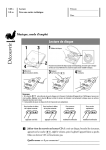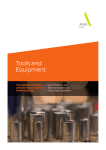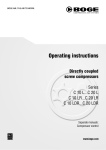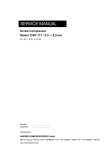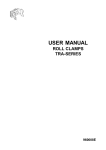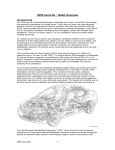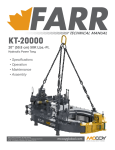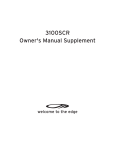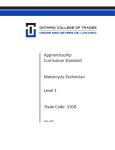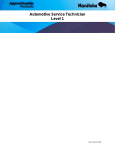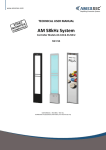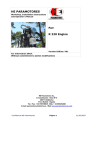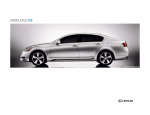Download Servicing Operations - Auto Skills Australia
Transcript
Servicing Operations THIS LEARNER WORKBOOK SUPPORTS THE AUTOMOTIVE COMPETENCY UNIT: AURTTA027 CARRY OUT BASIC VEHICLE SERVICING OPERATIONS © Auto Skills Australia This workbook has been developed to provide an example of how an RTO may approach the development of skills and knowledge related to units of competency. The workbook is an example only and RTOs are reminded they are responsible for ensuring that any learning and assessment strategies used must meet all regulatory requirements relevant to the role of an RTO. WHS/OHS training We recommend that learners complete the WHS/OHS unit AURASA002 Follow safe working practices in an automotive workplace before undertaking further study in this qualification. Disclaimer Auto Skills Australia has used its best endeavours to ensure that this assessment tool is correct and current at the time of publication, but does not give any warranty or accept any liability in relation to the contents. If any law prohibits the exclusion of such liability, Auto Skills Australia limits its liability to the extent permitted by law. This assessment tool has been developed to provide an example of how an RTO may approach the assessment of skills and knowledge related to units of competency. The tool is an example only and RTOs are reminded they are responsible for ensuring that any learning and assessment strategies used for assessment of an individual meet all regulatory requirements relevant to the role of an RTO. Safety Disclaimer Auto Skills Australia does not accept any liability for injury or damage in relation to these learning resources. This publication has been produced with the assistance of funding provided by the Commonwealth Government through the Australian Government Department of Industry. AURTTA027 Carry out basic vehicle servicing operations ©Auto Skills Australia Version: 1.0 / February 2014 Page 2 of 49 Table of Contents Introduction ........................................................................................................................................... 4 Topic 1: Prepare to Service .................................................................................................................... 5 1.1 Servicing information ................................................................................................................................... 5 1.2 Servicing safety – WHS/OHS ........................................................................................................................ 6 Topic 2: Servicing Fluids and Lubricants ................................................................................................ 7 2.1 Petroleum products ..................................................................................................................................... 7 2.2 Petrol and other fuels .................................................................................................................................. 8 2.3 Petroleum-‐based lubricants ....................................................................................................................... 10 2.4 Hydraulic fluid and brakes .......................................................................................................................... 11 Topic 3: Disposal and the Environment ............................................................................................... 12 Topic 4: Measurement ......................................................................................................................... 14 4.1 Servicing measurements ............................................................................................................................ 14 Topic 5: Lifting Vehicles ....................................................................................................................... 16 5.1 Lifting onto jack stands with a hydraulic floor jack .................................................................................... 16 5.2 Lifting with a hoist ...................................................................................................................................... 16 5.3 Safety checks .............................................................................................................................................. 17 5.4 Operating guidelines .................................................................................................................................. 17 5.5 Safety signs ................................................................................................................................................. 18 Topic 6: Servicing Tools and Materials Operational Guidelines .......................................................... 19 Topic 7: Servicing Tools and Materials ................................................................................................ 28 Topic 8: Variations to Servicing Schedule ............................................................................................ 33 Topic 9: Service and Report ................................................................................................................. 34 9.1 Servicing activities and assessment ........................................................................................................... 34 Service Record 1* ................................................................................................................................ 35 Service Record 2* ................................................................................................................................ 42 Topic 10: Completing the Work ........................................................................................................... 49 10.1 Inspection ................................................................................................................................................. 49 10.2 Cleaning up and storing tools ................................................................................................................... 49 10.3 Recording and reporting to the customer ................................................................................................ 49 10.4 Customer handover .................................................................................................................................. 49 AURTTA027 Carry out basic vehicle servicing operations ©Auto Skills Australia Version: 1.0 / February 2014 Page 3 of 49 Introduction Welcome to Servicing based on automotive competency unit AURTTA008 Participate in basic vehicle servicing operations. Study overview In this study you will learn how to service a vehicle. You will examine the many fluids that are used in servicing operations, the risks involved and how they must be handled. You will look at safely lifting vehicles on a hoist – an essential requirement for safe servicing operations. You will develop your ability to obtain information from a variety of sources and use it for servicing operations. Purpose To develop the knowledge and skills required for vehicle serving operations and to apply these in workshop activities. Content In this study you will learn about: • • • • • • servicing requirements hazards associated with servicing tools and materials used in servicing handling of fluids used in servicing servicing operations finalising a servicing operation. You will apply this learning in basic activities that will give you the underpinning skills to work safely in the automotive industry. Duration The guideline for this study is 20 hours. For most situations this means eight, two-hour sessions (or the equivalent in school periods) and up to three hours for revision and assessment. Your instructor may change this to suit your needs and past experience. Study notes These study notes can be used as evidence for your assessment. Spaces have been left for you to record your work as you progress. Please make every effort to complete the study notes. It will benefit you in the long run. Assessment When you undertake this study you will be required to complete the following assessment tasks. If you complete them successfully under the auspices of a registered training organisation (RTO) you may be awarded a statement of attainment for the competency unit AURTTA008 Participate in basic vehicle servicing operations. AURTTA027 Carry out basic vehicle servicing operations ©Auto Skills Australia Assessment tasks The assessment tasks you will complete are: 1. Workbook activities 2. A 40-question online test 3. Three servicing operations. The materials and supervision necessary to complete these tasks will be supplied by your training provider. Version: 0.1 / March 2014 Page 4 of 49 Topic 1: Prepare to Service 1.1 Servicing information You will not always have the servicing details of a service manual available and even the service manual may not give enough information to perform a lot of servicing tasks. External information sources such as Infomedia* publish datasheets for most makes and models of car. How do you access this? Activity 1: Sourcing information Search the internet for information on servicing two specific models of car or commercial vehicle. Report what you were able to find and comment on how useful it would be. Is it enough information to undertake a service to the vehicle manufacturer’s requirements? Infomedia* is a global organisation that supplies servicing information along with many other services that are of value to automotive technicians. Find the URL for Infomedia and note the range of services it provides. *INFOMEDIA – permission to use is being sought AURTTA027 Carry out basic vehicle servicing operations ©Auto Skills Australia Version: 0.1 / March 2014 Page 5 of 49 1.2 Servicing safety – WHS/OHS In many industries it is common to complete a form called a JSA (Job Safety Analysis) or SWMS (Safe Work Methods Statement) before starting any major work process. You may have seen this in the WHS/OHS unit as a hazard management plan. The table below is an example. Activity 2: Hazard management plan Look ahead to Topic 6, which sets out all the tasks to be completed in a full service. Select one set of tasks – cooling, engine, etc. – and complete this table for each of the subtasks, e.g. Check and adjust brake fluid. Share and compare your findings with others in your group. Servicing task 1. Subtask 2. Hazard AURTTA027 Carry out basic vehicle servicing operations ©Auto Skills Australia 3. Rating 4. Controls Version: 0.1 / March 2014 Page 6 of 49 5. Responsible Topic 2: Servicing Fluids and Lubricants Motor vehicles use many different fluids and lubricants. There are fluids in the brakes, transmission and clutch, and fuels (petrol, diesel fuel, biodiesel, LPG, natural gas and ethanol) are also fluids. Lubricants include grease and engine oil and transmission oil. While most of these come from oil refining processes, biodiesel and ethanol are produced from plant or animal sources. Natural gas comes directly from the ground. The following fluids play a role in the operation of vehicles and their servicing. 2.1 Petroleum products The crude oil from which fuels are produced is known as mineral oil, because it comes from the ground. Oil is believed to have originated from the bodies of marine animals and plants. Wells are drilled to tap the oil and bring it to the surface. Crude oil undergoes several processes in a refinery. One of the first steps is called fractional distillation. The crude oil is broken down into its various fractions. The fractions are determined by the temperature at which the various particles of oil separate. The crude oil is heated at the bottom of a tall hollow tower and turns to a vapour. As the vapour rises, it cools and distils to a liquid. At various levels in the tower, fractions are collected. The lighter products are collected towards the top of the tower and the denser ones distil closer to the bottom. A broad spectrum crude oil will distil into: • • • • • • gas – liquefied petroleum gas (LPG) solvents – part of paint motor spirit – petrol kerosene – jet fuel and heating fuel diesel fuels – replaces petrol in some vehicles furnace oil – used for industrial heating. Think Stock 481404963 AURTTA027 Carry out basic vehicle servicing operations ©Auto Skills Australia Version: 0.1 / March 2014 Page 7 of 49 2.2 Petrol and other fuels Petrol is made up of molecules composed of hydrogen and carbon atoms. When the air–fuel mixture burns, the hydrogen and carbon atoms unite with the oxygen atoms contained in the air to form water (H2O). This generates a large amount of heat. 2.2.1 Knocking, octane and grades of petrol During normal fuel combustion in an engine the pressure in the combustion chamber increases evenly, giving smooth running. If fuel burns too rapidly, there is a sudden increase in pressure that causes a ‘knock’. Fuel doesn’t burn evenly and is wasted. Knocking can damage the engine. Some engines have knock sensors fitted as part of the engine management system. These detect the early stages of knocking. The engine management system makes adjustments to the ignition and fuel systems to stop the knock. This causes a loss of engine power, but prevents harmful knocking. Meanwhile, on YouTube: The Story of Gasoline – 1950s educational documentary 20 minutes http://www.youtube.com/ watch?v=EyTSrEsnFf4 Fuels are tested for their resistance to knocking and given a research octane number (RON). A high-octane fuel resists knocking, while a lowoctane fuel knocks easily. A mixture of the two fuels can be used to produce a fuel of any octane number. Until the 1980s petrol that was marketed as super or leaded petrol contained a small quantity of tetraethyl lead that was used to give it a high octane number. Lead produces harmful emissions from the engine’s exhaust. Leaded petrol was phased out nationally by 1 January 2002. Petrol is now available several grades: • • • ULP – 91 RON Premium – 95 RON (or 98 RON) Premium extra – 100 RON. As well as reducing harmful emissions, unleaded petrol enabled catalytic converters to be used in exhaust systems and these are fitted to all new vehicles. Catalytic converters remove other emissions, but cannot be used with leaded fuel. AURTTA027 Carry out basic vehicle servicing operations ©Auto Skills Australia Version: 0.1 / March 2014 Page 8 of 49 2.2.2 Other fuels Ethanol is a type of alcohol (C2H5OH) that is produced by fermenting and distilling sugars. It is classified as a biofuel. The main advantages of blending ethanol and petrol are that ethanol burns very cleanly with low emissions and it has a higher RON of 129. The ethanol boosts the octane rating of the fuel blend. The main disadvantages of ethanol are that it is not suitable for older carburetted vehicles and is more expensive to produce. It hardens older rubber components such as fuel pump diaphragms and hoses and can cause failure. The ethanol will also clean old fuel deposits in the tank and fuel lines and quickly block fuel filters when first used. Ethanol is more volatile and can cause driveability problems, such as stalling and flat spots created by vapour locks. Gas fuels The two gas fuels that are used for motor vehicles are liquefied petroleum gas (LPG) and natural gas for vehicles (NGV). Both gases are hydrocarbons, as is petrol, but LPG and NGV have different chemical compositions. Liquid petroleum gas LPG is one of the products of crude oil refining. It consists mainly of propane and butane. Because LPG is colourless, odourless and tasteless, it has a chemical added to give it a strong smell. This means LPG can be detected if there is a gas leak. LPG is twice as dense as air so leaking gas will flow downward. It will concentrate in low areas, such as pits and drains. Natural gas for vehicles NGV is a natural gas that consists mainly of methane. It comes from the ground, where it was formed by decomposing vegetable and other matter. Some NGV is also obtained during the processing of crude oil. AURTTA027 Carry out basic vehicle servicing operations ©Auto Skills Australia Version: 0.1 / March 2014 Page 9 of 49 Diesel fuels Diesel fuels are the denser parts of refined crude oil. These chemicals must be fine enough to be atomised in the cylinder, but heavy enough to adhere to the engine parts as a lubricant. Diesel fuels are given a rating like the octane rating. It is called the cetane rating. Diesel fuels are mixed to optimise performance and cetane rating. Biodiesel is made from vegetable oil and animal fats. It is a clean burning fuel with no sulphur. 2.3 Petroleum-based lubricants 2.3.1 Lubricant functions In 1999, it was estimated that approximately 40 billion litres of lubricants were consumed worldwide. One of the largest single uses for lubricants is protecting the internal combustion engines in motor vehicles. Lubricants reduce friction between moving surfaces. They also remove foreign particles, among other things. The most common petroleum-based lubricant used in engines is engine oil. Lubricants also perform the following key functions. They: • • • • • • • reduce friction between moving parts remove heat transmit power – hydraulics reduce wear limit corrosion act as a seal for gases – seal the piston/cylinder space reduce rust. A good lubricant has the following characteristics: • • • • • • high boiling temperature low freezing temperature high viscosity thermally stable hydraulically stable high resistance to oxidation. Typically, lubricants contain 90% base oil (most often petroleum fractions, called mineral oils) and less than 10% additives. Additives deliver reduced friction and wear and increased viscosity. Additives can be: • • • • antioxidants detergents metal deactivators corrosion inhibitors AURTTA027 Carry out basic vehicle servicing operations ©Auto Skills Australia • • • • friction modifiers anti-foaming agents viscosity index improvers demulsifying/emulsifying. Version: 0.1 / March 2014 Page 10 of 49 Activity 3: Additive hazards Use the internet to determine the safety risk associated with three of these additives. Explain your findings. Lubricants are typically used to separate moving parts in a system by forming a physical barrier, i.e., a thin layer of lubricant separates the moving parts. This is similar to hydroplaning in a car when the car’s tyres are separated from the road surface by moving through standing water. 2.3.2 Grease Grease is a lubricant that is used in bearings, ball joints and many other places where oil is not suitable. It is a semi-solid consisting of two parts: • • a lubricant, which is an oil a base that carries the oil. The base is made of animal or vegetable fat mixed with a metal compound – sodium, calcium, lithium, aluminium or zinc are common. Grease is categorised with a rating called the NLGI number (National Lubricating Grease Institute). Values range from NLGI 000 for the thinnest grease to NLGI 6 for the thickest. 2.3.3 Transmission oils An automatic transmission has bands and clutches that require lubrication like other engine parts, but they also need friction to grip moving parts. These are two opposing requirements for which automatic transmission fluids have to cater. 2.4 Hydraulic fluid and brakes The hydraulic fluid used in braking systems is usually glycol ether – a derivative of oil refining. Brake fluids are classified using a DOT rating. DOT stands for Department of Transport (an American term). • • • DOT 3 is suitable for most common cars DOT 4 is similar to DOT 3 with a higher boiling point DOT 5 meets higher standards of performance and has a high boiling point. DOT 5 can be used in common cars but DOT 3 must not be used in high-performance cars. Brake fluid is easily contaminated by mineral oil, kerosene and other mineral oil products. Rubber seals will swell and deteriorate in the presence of these contaminants. If brake fluid is contaminated it should be replaced along with all associated seals and hoses. AURTTA027 Carry out basic vehicle servicing operations ©Auto Skills Australia Version: 0.1 / March 2014 Page 11 of 49 Topic 3: Disposal and the Environment There are strict regulations about the disposal of lubricants in landfill or discharge into water systems. Lubricants will contaminate water and land even in small amounts. Burning lubricants generates airborne pollutants that are full of toxic materials, mainly heavy metal compounds. Lubricant burning is only allowed in specialised facilities that have equipment to scrub airborne pollutants before they reach the atmosphere. Some landfill sites may have permits to deal with toxic wastes. The common use of vehicles leads to some release of lubricant directly into the environment. It gets into drains and landfills. Another direct source of contamination is runoff from roads, spills, natural disasters and pipeline leakages. Activity 4: Environmental hazards It is estimated that 40% of all lubricants are released into the environment. What hazards might come from that? List at least three problems. Item number: 86534146 1. 2. 3. 3.1 Lubricant disposal Improving technologies have made lubricant recycling a viable option. Filtration systems can remove particulates, additives and oxidation products and recover the base oil. This base oil is then treated much the same as virgin base oil, but there is considerable reluctance to use recycled oil as it is generally considered to be inferior. Used lubricant may also be used as refinery feedstock to become part of crude oil. Cost prohibits treating used lubricants with both filtration and re-refining. The primary problem with recycling still remains the collection of fluids. Refineries need continuous supply in amounts measured in thousands of litres, which generally comes from oil wells. When used lubricant requires disposal the best option is to return it to the retailer where it can be reprocessed. Local councils often have oil recycling programs and in some areas recyclers will pick up used oil. Activity 5: Waste disposal Where is your nearest lubricant retailer if you need to dispose of waste lubricant? AURTTA027 Carry out basic vehicle servicing operations ©Auto Skills Australia Version: 0.1 / March 2014 Page 12 of 49 Activity 6: First aid alert You are disposing of brake fluid when you accidently get some in your mouth. Use the Material Safety Data Sheet to determine what actions and treatment you should use to control the situation. You will need to select a product on the internet and download the MSDS. List your first aid actions. AURTTA027 Carry out basic vehicle servicing operations ©Auto Skills Australia Version: 0.1 / March 2014 Page 13 of 49 Topic 4: Measurement Feet and inches are units in the old ‘imperial’ measurement system that was replaced by the metric system in Australia between 1970 and 1988. In industry generally, most measurements are made in metric units, such as metres, millimetres and kilometres. In the automotive industry you will find some parts are described in inches or feet. The reason this still occurs is that some countries, such as the United States, use imperial measurement and they are a supplier of parts used in cars in Australia. Two Feet? Item number:153699443 4.1 Servicing measurements A micrometer is a tool that can measure small distances of less than a millimetre or larger distances with an accuracy of 1/100th of a millimetre. Unless measurements taken from pistons and other internal components are this accurate a vehicle engine may run rough or not run at all. When you are servicing a vehicle you will need to make several measurements, from the amount of water in the windscreen washers (not very accurate) to the thickness of the lining on brakes (very accurate and possibly a very small distance). We can break measurement into several parts: • • • the commodity (the thing) being measured – steel, cheese, wind, light the unit of measurement – length, weight, speed, lumens the measuring device – measuring tape, scales, anemometer, lux meter. How many measurements are involved in servicing a car? We are going to explore this and develop our knowledge of measurement as a crucial skill for all mechanics and service technicians. Activity 7: Measurement Complete the table as fully as you can. An example has been provided. There is no one right answer. Try to get as many measurements as possible. AURTTA027 Carry out basic vehicle servicing operations ©Auto Skills Australia Version: 0.1 / March 2014 Page 14 of 49 Servicing measurements The commodity Unit of measurement Measuring device Brake lining thickness Millimetres Micrometer AURTTA027 Carry out basic vehicle servicing operations ©Auto Skills Australia Version: 0.1 / March 2014 Page 15 of 49 Topic 5: Lifting Vehicles Many of the tasks required to service a vehicle involve lifting the vehicle on a hoist or a hydraulic floor jack. 5.1 Lifting onto jack stands with a hydraulic floor jack Vehicles being serviced will usually be lifted on a hydraulic jack and placed on jack stands or safety stands. This allows wheels to be changed and for limited work to be performed under the vehicle. • • • • Make the first lift at the rear of the vehicle. Align the lifting point on the hydraulic floor jack with the strongest part of the under door sill or a specified lifting point under the vehicle – see vehicle manual or servicing database. Lift the vehicle to the required height then place jack stands under the wheel axles or other designated strength point. Lower the floor jack but leave it in position as an additional safety device. 5.2 Lifting with a hoist Activity 8: Lifting When a vehicle is lifted above head height a full range of undervehicle tasks can be performed. List six tasks. 1. 2. 3. 4. 5. 6. The hoist in your workshop has been chosen to meet the needs of the business or school. The skills you develop can be applied to the wide variety of hoists you will encounter in your automotive career. We have looked at hoists earlier in the course and this time we will look at hoists with a strong emphasis on safety. A hoist has the capacity to cause serious injury and could kill an operator if not used safely. AURTTA027 Carry out basic vehicle servicing operations ©Auto Skills Australia Version: 0.1 / March 2014 Page 16 of 49 5.3 Safety checks Before a hoist can be used all the following conditions must be met. • • • • • • • • • • A vehicle hoist must not be operated unless it has a current certificate of inspection. Ensure the vehicle hoist has operating and maintenance instructions permanently located and clearly visible. The hoist must be used in accordance with the manufacturer’s instructions. Check the capacity of the hoist compared to the weight of the vehicle. If the vehicle is too heavy, do not proceed. Ensure the area is clean and clear of grease, oil, and objects that may be a slip/trip hazard. Familiarise yourself with and check all machine operations and controls. Check that all safety devices are in good condition. Ensure support arms are capable of being locked in position. Ensure rubber pads are in good condition on all load points. Faulty equipment must be reported immediately it is discovered. 5.4 Operating guidelines In addition to the safety checks specific to the hoist in your workshop, the following factors should always be considered. • • • • • • • • • • Centre the vehicle on the hoist, ensuring that the weight is evenly distributed to the front and rear. Identify the correct jacking points and place the lifting pads under the vehicle at the front and rear on the jacking points, ensuring contact. Only one person operates the hoist at a time. Ensure hoist area is clear of people and equipment before operating. Never leave the hoist running unattended. Check vehicle stability by looking at the jacking points. Engage the manual lock when the required height is reached. At the completion of work, lower the vehicle hoist and ensure all equipment is left in a safe position. Switch off equipment. Leave the equipment and work area in a safe, clean and tidy state. AURTTA027 Carry out basic vehicle servicing operations ©Auto Skills Australia Version: 0.1 / March 2014 Page 17 of 49 5.5 Safety signs The following safety signs should be visible when working on the hoist. Jewellery Safety glasses must be worn at all times in work areas. Long and loose hair must be contained. Safety footwear must be worn at all times in work areas. Close fitting/protective clothing must be worn. Rings and jewellery must not be worn. Do not stand on hoist while hoist is in operation. Material in 5.3 to 5.5 adapted from Safety Operating Procedures – Vehicle Hoists, published by Department for Education and Childhood Development, South Australia. AURTTA027 Carry out basic vehicle servicing operations ©Auto Skills Australia Version: 0.1 / March 2014 Page 18 of 49 Topic 6: Servicing Tools and Materials Operational Guidelines Activity 9: Servicing tools – selection and maintenance Your instructor will demonstrate a standard service. You will observe and you may be asked to help from time to time. You will be performing services on several cars as part of your assessment. The notes you make here will help you complete your assessment successfully. While observing this demonstration, in the pages that follow you will: • • • • • list all the tools and materials needed to complete the servicing checks, adjustments and replacement for each system covered by the service note the time taken to perform each task note whether the task is under bonnet (UB) or under car (UC) – some tasks may be neither (NA) or both (UB/UC) note when each task is performed – i.e. every 5,000 km, 10,000 km, six months, etc. Refer to May and Simpson, volume 1, page 635 for guidance. make any other notes that will be useful to your study and learning. System or component Action items UB/UC Tools Materials Preliminary check 1. WHS / OHS checks Examine the work area and identify any potential hazards Report hazards requiring management action Resolve all other issues locally with appropriate controls Steering and suspension 2. Steering linkage 3. Wheel alignment Check steering wheel rotational free play Check linkage ball joints for looseness and wear Lubricate the ball joints where possible Check the steering and suspension as scheduled Check and adjust front-end alignment AURTTA027 Carry out basic vehicle servicing operations ©Auto Skills Australia Version: 0.1 / March 2014 Page 19 of 49 Time taken Notes System or component 4. Steering box or housing Action items 5. Front suspension 6. Wheel bearings 8. Body and chassis Tools Materials Check ‘worm’ steering box for operation and oil level and possible leaks Check the condition of the boots on rack-and-pinion steering Check power steering operation and fluid levels Check for wear on the suspension ball joints Check ball joint boots for damage Lubricate suspension ball joints, where possible Check shock absorbers or strut for leaks Check the condition of the shock absorber boots Inspect the suspension generally for wear and damage Where required: 7. Rear suspension UB/UC Clean front wheel bearings and repack with grease Clean and repack rear wheel bearings on some front-wheel-drive vehicles Check the bushes and mountings Check shock absorber operation Check for oil leaks around shock absorbers Replace faulty shock absorbers Check bolts and nuts on body, chassis or sub-frames Use a torque wrench where a torque is specified AURTTA027 Carry out basic vehicle servicing operations ©Auto Skills Australia Version: 0.1 / March 2014 Page 20 of 49 Time taken Notes System or component Action items UB/UC Tools Materials Drive line 9. Drive line 10. Final drive Check the drive line components for wear or damage Check drive line universal joints for wear Check the condition of the boots and seals on constant-velocity joints Lubricate universal joints where required Check oil level of the rear axle Check for gasket and seal leaks Check that the vent on the rear axle housing or differential housing is clear Check the brake fluid level Replace the fluid at the specified service period Check brake fittings for leaks. Check for other forms of damage or wear Check disc brake pads for wear Replace worn pads Check brake discs for scoring Have scored discs ground Check the pedal free play and pedal travel Check the operation of the brake booster Check and adjust drum brakes Braking 11. Brake fluid 12. Brake lines and hoses 13. Brake linings and pads 14. Brake pedal AURTTA027 Carry out basic vehicle servicing operations ©Auto Skills Australia Version: 0.1 / March 2014 Page 21 of 49 Time taken Notes System or component 15. Parking brake Action items UB/UC Tools Materials Check and adjust parking brake if the travel is excessive Wheels and tyres 16. Tyres and wheels Inspect the tyres and rims for damage Check tyre inflation Rotate the tyres to even up the wear Check wheel nuts for tightness Check and adjust the clutch pedal free play For a hydraulic clutch: o Check and adjust the fluid level in the master cylinder o Check for hydraulic leaks o Change the fluid where specified Transmission 17. Clutch 18. Manual transmission 19. Automatic transmission Check and adjust the oil level of the oil in the transmission or transaxle Check for oil leaks Change the fluid where specified Check the automatic transmission fluid level with the transmission hot Check for leaks Engine system 20. Engine 21. Valve clearance Inspect engine assembly for fuel, oil, coolant and other leaks; determine necessary action Inspect valve clearances in warm engine and adjusted to specifications AURTTA027 Carry out basic vehicle servicing operations ©Auto Skills Australia Version: 0.1 / March 2014 Page 22 of 49 Time taken Notes System or component 22. Manifold bolts Action items 23. Drive belts 24. Engine oil UB/UC Tools Materials Inspect bolts or nuts connecting the manifolds to the cylinder head Adjust bolts and nuts for tightness to eliminate leaks Inspect and adjust nuts and bolts for the exhaust pipe at the manifold flange Inspect camshaft drive belts Replace at correct service interval or when damaged or excessively worn Check and adjust belts for the fan, alternator, air-conditioner and power steering Replace belts with wear Adjust the belt tension to the required deflection Replace engine oil at scheduled intervals Change oil filter with change of oil Check and replace the drain plug washer if worn Check for oil leaks Battery and electrical 25. Battery Clean the battery Inspect for damage to the battery case and for looseness and corrosion in the terminals Top up the cells with deionised water Check the level of the electrolyte in the battery and measure its density with a hydrometer Test the battery for electrical load performance level and confirm it is sufficient for the vehicle type Apply a coating of grease to the battery terminals AURTTA027 Carry out basic vehicle servicing operations ©Auto Skills Australia Version: 0.1 / March 2014 Page 23 of 49 Time taken Notes System or component Action items 26. Lighting 27. Instruments 28. Power windows and mirrors UB/UC Tools Materials Check the operation of indicator lights, hazard warning and stop lights Replace faulty globe or identify other causes for not operating Check all indicator, warning and instruments lights to ensure that they are all operating Check the operation of the power windows, mirrors and door locks Obtain idle information from service manual Check and adjust the engine idle speed to the prescribed rate Adjust the idle speed in accordance with the emission-control information Fuel system 29. Petrol engine – idle speed 30. Petrol engine – air cleaner 31. Petrol engine – choke 32. Petrol engine – fuel filter Inspect the air cleaner Clean the air cleaner with compressed air Replace the air cleaner, if damaged or due, according to the schedule Check and adjust the cable of a manual choke on a carburettor engine Check choke valve position for automatic choke Check and replace line filter if fitted according to schedule Check for fuel leaks AURTTA027 Carry out basic vehicle servicing operations ©Auto Skills Australia Version: 0.1 / March 2014 Page 24 of 49 Time taken Notes System or component 33. Petrol engine – fuel lines 34. Petrol engine – fuel tank cap Action items Check the condition of fuel system hoses, pipes and connections Check the fuel cap is in good condition and the correct type Check that the washer seals on the filler neck of the tank Replace the fuel cap with the correct type of cap 35. Diesel engine – fuel lines 36. Diesel engine – fuel filters Clean filters or replace as required and drain water from the sedimentor Prime and bleed the system Check for leaks 37. Diesel engine – air cleaner Clean or replace the air cleaner Check air hoses and ducts for leaks 38. Diesel engine – injectors Check that injectors are operational Check as required 39. Diesel engine – injection timing UB/UC Tools Materials Check connections to the filter, fuel pump and injection pump Check injector pipes for tightness and leaks AURTTA027 Carry out basic vehicle servicing operations ©Auto Skills Australia Version: 0.1 / March 2014 Page 25 of 49 Time taken Notes System or component 40. Petrol engine – spark plugs 41. Petrol engine – distributor and cables Action items Clean and check spark plugs Adjust spark plug gap Replace spark plugs when specified or when faulty Clean the distributor cap Check the HT cables Clean distributor rotor Inspect the cap for cracks or damage Check and adjust the contact points for wear and pitting. Renew if necessary Check dwell time and reset the ignition timing Check and adjust ignition timing Check the ignition advance UB/UC Tools Materials Cooling system 42. Cooling system 43. Coolant Check coolant level is above the minimum mark in the reservoir and adjust as required Check cooling system hose connections Check all heater hoses for leaks Clean radiator core by blowing air through it from the rear Check the water pump for leaks Check fan condition Drain and flush cooling system according to schedule Drain coolant from heater core Refill cooling system with coolant including water and correct additives for vehicle and environment AURTTA027 Carry out basic vehicle servicing operations ©Auto Skills Australia Version: 0.1 / March 2014 Page 26 of 49 Time taken Notes System or component Action items UB/UC Tools Materials Time taken Notes Emission system 44. Emission hoses 45. Exhaust system Check emission control components for condition and leaks Check and replace charcoal canister according to vehicle schedule and canister condition Check for correct operation of the positive crankcase ventilation (PCV) valve Clean or replace as necessary There are many variations in emission controls. Information is available in the relevant workshop manual Check the exhaust system for condition and leaks at the pipe joints Check the exhaust mountings for condition and for clearance with the body or suspension Back-up checks 46. Fluid checks Check and adjust engine oil level Check and adjust engine coolant level Check and adjust power steering fluid level Check and adjust brake fluid level Check and adjust windshield washer fluid level Check and replace wiper blades Check and adjust differential/transfer case fluid level Check and adjust transmission fluid level Adapted from: AURTTA008 Participate in basic vehicle servicing operations – Knowledge Evidence; May, E. and Simpson, L., Automotive Mechanics, Volume 1, 8th edition, published by McGraw Hill. ASE Program Certification Standards For General Service Technician Programs, http://www.schools.utah.gov/cte/documents/sts/standards/GeneralServiceTechnician.pdf AURTTA027 Carry out basic vehicle servicing operations ©Auto Skills Australia Version: 0.1 / March 2014 Page 27 of 49 Topic 7: Servicing Tools and Materials The list below can be used to help you identify the tools and materials (fluids, etc.) required to perform each task in the servicing process. You may, and probably should, identify other tools and materials beyond this list. 1. Spanners 2. Socket spanners 3. Adjusting or shifting spanners 4. Torque wrenches AURTTA008 ©Auto Skills Australia Version: 1.0 / February 2014 Page 28 of 49 5. Hex/Allen key 6. Screwdrivers 7. Oil filter remover 8. Pliers 9. Files 10. Hacksaws AURTTA008 ©Auto Skills Australia Version: 1.0 / February 2014 Page 29 of 49 11. Engineer’s hand hammers 12. Cold chisel and punch 13. Fastening hardware 14. Drills AURTTA008 ©Auto Skills Australia Version: 1.0 / February 2014 Page 30 of 49 15. Drill bits 16. Electric power wrenches 17. Grinders 18. Air or pneumatic tools AURTTA008 ©Auto Skills Australia Version: 1.0 / February 2014 Page 31 of 49 19. Lifting equipment – jacks and supports ThinkStock 465216769 20. Lifting equipment – hoists 21. Fluids The following fluids are used in most servicing processes. List any others you use or see your instructor using. Petrol Gas fuel Lubricants . . . Grease Transmission oil Hydraulic fluids . . . Activity 10: Adopt a tool Select a tool you are not familiar with and ask your instructor to demonstrate its use. Practise using the tool until you are able to use it without concern. Note the tool and its function below. AURTTA008 ©Auto Skills Australia Version: 1.0 / February 2014 Page 32 of 49 Topic 8: Variations to Servicing Schedule A typical cycle for servicing modern vehicles is every 15,000 kilometres or every 12 months – whichever comes first. Most servicing tasks are repeated at each service, but some are not required as frequently The table below gives a summary of these less frequent tasks. Servicing task Valve clearance Variation to servicing schedule Adjust at 2,000, 30,000 and 60,000 km Manifold bolts Tighten at 2,000, 30,000 and 60,000 km Engine coolant Replace at 30,000 and 60,000 km Air cleaner Replace at 30,000 and 60,000 km Choke operation Inspect at 30,000 and 60,000 km Fuel filter – diesel or petrol Replace at 30,000 and 60,000 km Injection timing – diesel Check at 30,000 and 60,000 km Spark plugs Replace at 30,000 and 60,000 km Ignition timing – petrol Adjust at 2,000, 30,000 and 60,000 km Charcoal canister Replace at 30,000 and 60,000 km Brake fluid Replace at 30,000 and 60,000 km Wheel alignment Adjust at 30,000 and 60,000 km Steering box Check at 2,000, 30,000 and 60,000 km Front/rear wheel bearings – to suit vehicle Lubricate Replace at 30,000 This information is generic and does not apply to any specific vehicle. Detailed, vehicle-specific information can be obtained from manufacturers or dealers and from sources such as Infomedia, which publishes data on most makes and models of cars. You can feed this information back into your servicing guidelines, above. AURTTA008 ©Auto Skills Australia Version: 1.0 / February 2014 Page 33 of 49 Topic 9: Service and Report 9.1 Servicing activities and assessment You will work through four main steps to learn, practise and be assessed in vehicle servicing. The four steps are: 1. Demonstration. Your instructor will perform a demonstration service, explaining the tools and materials used. Record this on the pages below. 2. Practise. Your group – two or three fellow students – will complete a service on selected systems (brakes, fuel etc.) and your peers will time you and record these times in the table below. You will complete the Service Record 1 as you proceed. 3. Assessment. Your group will service another vehicle observed by your instructor or another assessor. You may be called on by your instructor to only service some aspects of a vehicle. You will follow all the required procedures, but not for every system. You will complete the Service Record 2 as you proceed. 9.2 Inspection Your work on the Task 3 assessment will include a detailed inspection of your work, including criticism. You will correct any errors to produce a completely satisfactory outcome. AURTTA008 ©Auto Skills Australia Version: 1.0 / February 2014 Page 34 of 49 Service Record 1* Customer: Vehicle make and model: Odometer: Date of service: Date of last service: Technician comments: Next service due: / Odometer or Date / Service technician number: * Your instructor or assessor will tell you which systems to service. AURTTA008 ©Auto Skills Australia Version: 1.0 / February 2014 Page 35 of 49 System or component Action items U/B:U/C Notes Preliminary check 1 WHS/OHS checks Examine the work area and identify any potential hazards Report hazards requiring management action Resolve all other issues locally with appropriate controls Steering and suspension system 2 Steering linkage 3 Wheel alignment Check steering wheel rotational free play Check linkage ball joints for looseness and wear Lubricate the ball joints where possible Check the steering and suspension as scheduled Check and adjust front-end alignment 4 Steering box or housing 5 Front suspension 6 Wheel bearings 8 Body and chassis Check for wear on the suspension ball joints Check ball joint boots for damage Lubricate suspension ball joints, where possible Check shock absorbers or strut for leaks Check the condition of the shock absorber boots Inspect the suspension generally for wear and damage Where required: 7 Rear suspension Check ‘worm’ steering box for operation and oil level and possible leaks Check the condition of the boots on rack-andpinion steering Check power steering operation and fluid levels Clean front-wheel bearings and repack with grease Clean and repack rear-wheel bearings on some front-wheel-drive vehicles Check the bushes and mountings Check shock absorber operation Check for oil leaks around shock absorbers Replace faulty shock absorbers Check bolts and nuts on body, chassis or subframes Use a torque wrench where a torque is specified AURTTA008 ©Auto Skills Australia Version: 1.0 / February 2014 Page 36 of 49 System or component Action items U/B:U/C Notes Drive line system 9 Drive line 10 Final drive Check the drive line components for wear or damage Check drive line universal joints for wear Check the condition of the boots and seals on constant-velocity joints Lubricate universal joints where required Check oil level of the rear axle Check for gasket and seal leaks Check that the vent on the rear axle housing or differential housing is clear Check the brake fluid level Replace the fluid at the specified service period Check brake fittings for leaks Check for other forms of damage or wear Check disc brake pads for wear Replace worn pads Check brake discs for scoring Have scored discs ground Check the pedal free play and pedal travel Check the operation of the brake booster Check and adjust drum brakes Check and adjust parking brake if the travel is excessive Braking system 11 Brake fluid 12 Brake lines and hoses 13 Brake linings and pads 14 Brake pedal 15 Parking brake Wheels and tyres 16 Tyres and wheels Inspect the tyres and rims for damage Check tyre inflation Rotate the tyres to even up the wear Check wheel nuts for tightness Transmission system 17 Clutch 18 Manual transmission Check and adjust the clutch pedal free play For a hydraulic clutch: o Check and adjust the fluid level in the master cylinder o Check for hydraulic leaks o Change the fluid where specified Check and adjust the oil level of the oil in the transmission or transaxle Check for oil leaks AURTTA008 ©Auto Skills Australia Version: 1.0 / February 2014 Page 37 of 49 System or component 19 Automatic transmission Action items Change the fluid where specified Check the automatic transmission fluid level with the transmission hot Check for leaks U/B:U/C Notes Engine system 20 Engine 21 Valve clearance 22 Manifold bolts Inspect engine assembly for fuel, oil, coolant, and other leaks; determine necessary action Inspect valve clearances in warm engine and adjust to specifications Inspect bolts or nuts connecting the manifolds to the cylinder head Adjust bolts and nuts for tightness to eliminate leaks Inspect and adjust nuts and bolts for the exhaust pipe at the manifold flange 23 Drive belts Inspect camshaft drive belts Replace at correct service interval or when damaged or excessively worn Check and adjust belts for the fan, alternator, air-conditioner and power steering Replace belts with wear Adjust the belt tension to the required deflection Replace engine oil at scheduled intervals Change oil filter with change of oil Check and replace the drain plug washer if worn Check for oil leaks 24 Engine oil Battery and electrical system 25 Battery 26 Lighting 27 Instruments AURTTA008 ©Auto Skills Australia Clean the battery Inspect for damage to the battery case and for looseness and corrosion in the terminals Top up the cells with deionised water Check the level of the electrolyte in the battery and measure its density with a hydrometer Test the battery for electrical load performance level and confirm it is sufficient for the vehicle type Apply a coating of grease to the battery terminals Check the operation of indicator lights, hazard warning and stop lights Replace faulty globe or identify other causes for not operating Check all indicator, warning and instrument lights to ensure that they are all operating Version: 1.0 / February 2014 Page 38 of 49 System or component 28 Power windows and mirrors Action items Check the operation of the power windows, mirrors and door locks Obtain idle information from service manual Check and adjust the engine idle speed to the prescribed rate Adjust the idle speed in accordance with the emission-control information U/B:U/C Notes Fuel System 29 Petrol engine – idle speed 30 Petrol engine – air cleaner 31 Petrol engine – choke Inspect the air cleaner Clean the air cleaner with compressed air Replace the air cleaner, if damaged or due, according to the schedule Check and adjust the cable of a manual choke on a carburettor engine Check choke valve position for automatic choke 32 Petrol engine – fuel filter 33 Petrol engine – fuel lines Check the condition of fuel system hoses, pipes and connections Check the fuel cap is in good condition and the correct type Check that the washer seals on the filler neck of the tank Replace the fuel cap with the correct type of cap 34 Petrol engine – fuel tank cap Check and replace line filter if fitted according to schedule Check for fuel leaks 35 Diesel engine – fuel lines 36 Diesel engine – fuel filters Clean filters or replace as required and drain water from the sedimentor Prime and bleed the system Check for leaks 37 Diesel engine – air cleaner Clean or replace the air cleaner Check air hoses and ducts for leaks 38 Diesel engine – injectors Check that injectors are operational Check as required 39 Diesel engine – AURTTA008 ©Auto Skills Australia Check connections to the filter, fuel pump and injection pump Check injector pipes for tightness and leaks Version: 1.0 / February 2014 Page 39 of 49 System or component Action items U/B:U/C Notes injection timing 40 Petrol engine – spark plugs 41 Petrol engine – distributor and cables Clean and check spark plugs Adjust spark plug gap Replace spark plugs when specified or when faulty Clean the distributor cap Check the HT cables Clean distributor rotor Inspect the cap for cracks or damage Check and adjust the contact points for wear and pitting. Renew if necessary Check dwell time and reset the ignition timing Check and adjust ignition timing Check the ignition advance Cooling system 42 Cooling system 43 Coolant Check coolant level is above the minimum mark in the reservoir and adjust as required Check cooling system hose connections Check all heater hoses for leaks Clean radiator core by blowing air through it from the rear Check the water pump for leaks Check fan condition Drain and flush cooling system according to schedule Drain coolant from heater core Refill cooling system with coolant including water and correct additives for vehicle and environment Emission system 44 Emission hoses 45 Exhaust system Check emission control components for condition and leaks Check and replace charcoal canister according to vehicle schedule and canister condition Check for correct operation of the positive crankcase ventilation (PCV) valve Clean or replace as necessary There are many variations in emission controls. Information is available in the relevant workshop manual Check the exhaust system for condition and leaks at the pipe joints Check the exhaust mountings for condition and for clearance with the body or suspension Back-up checks 46 Fluid checks AURTTA008 ©Auto Skills Australia Check and adjust engine oil level Check and adjust engine coolant level Check and adjust power steering fluid level Check and adjust brake fluid level Version: 1.0 / February 2014 Page 40 of 49 System or component Action items U/B:U/C Notes Check and adjust windshield washer fluid level Check and replace wiper blades Check and adjust differential/transfer case fluid level Check and adjust transmission fluid level Customer report Write a short report to the customer outlining additional tasks performed and recommending work required in the near future. Service Task 1: Customer recommendations AURTTA008 ©Auto Skills Australia Version: 1.0 / February 2014 Page 41 of 49 Service Record 2* Customer: Vehicle make and model: Odometer: Date of service: Date of last service: Technician comments: Next service due: / Odometer or Date / Service technician number: * Your instructor or assessor will tell you which systems to service. AURTTA008 ©Auto Skills Australia Version: 1.0 / February 2014 Page 42 of 49 System or component Action items U/B:U/C Notes Preliminary check 1 WHS / OHS checks Examine the work area and identify any potential hazards Report hazards requiring management action Resolve all other issues locally with appropriate controls Steering and suspension system 2 Steering linkage 3 Wheel alignment Check steering wheel rotational free play Check linkage ball joints for looseness and wear Lubricate the ball joints where possible Check the steering and suspension as scheduled Check and adjust front-end alignment 4 Steering box or housing 5 Front suspension 6 Wheel bearings 8 Body and chassis Check for wear on the suspension ball joints Check ball joint boots for damage Lubricate suspension ball joints, where possible Check shock absorbers or strut for leaks Check the condition of the shock absorber boots Inspect the suspension generally for wear and damage Where required: 7 Rear suspension Check ‘worm’ steering box for operation and oil level and possible leaks Check the condition of the boots on rack-andpinion steering Check power steering operation and fluid levels Clean front wheel bearings and repack with grease Clean and repack rear wheel bearings on some front-wheel-drive vehicles Check the bushes and mountings Check shock absorber operation Check for oil leaks around shock absorbers Replace faulty shock absorbers Check bolts and nuts on body, chassis or subframes Use a torque wrench where a torque is specified Drive line system 9 Drive line AURTTA008 ©Auto Skills Australia Check the drive line components for wear or damage Check drive line universal joints for wear Check the condition of the boots and seals on Version: 1.0 / February 2014 Page 43 of 49 System or component Action items 10 Final drive U/B:U/C Notes constant-velocity joints Lubricate universal joints where required Check oil level of the rear axle Check for gasket and seal leaks Check that the vent on the rear axle housing or differential housing is clear Check the brake fluid level Replace the fluid at the specified service period Check brake fittings for leaks Check for other forms of damage or wear Check disc brake pads for wear Replace worn pads Check brake discs for scoring Have scored discs ground Check the pedal free play and pedal travel Check the operation of the brake booster Check and adjust drum brakes Check and adjust parking brake if the travel is excessive Braking system 11 Brake fluid 12 Brake lines and hoses 13 Brake linings and pads 14 Brake pedal 15 Parking brake Wheels and tyres 16 Tyres and wheels Inspect the tyres and rims for damage Check tyre inflation Rotate the tyres to even up the wear Check wheel nuts for tightness Transmission system 17 Clutch 18 Manual transmission Check and adjust the clutch pedal free play For a hydraulic clutch: o Check and adjust the fluid level in the master cylinder o Check for hydraulic leaks o Change the fluid where specified Check and adjust the oil level of the oil in the transmission or transaxle Check for oil leaks Change the fluid where specified 19 Automatic transmission AURTTA008 ©Auto Skills Australia Check the automatic transmission fluid level with the transmission hot Check for leaks Version: 1.0 / February 2014 Page 44 of 49 System or component Action items U/B:U/C Notes Engine system 20 Engine 21 Valve clearance 22 Manifold bolts Inspect engine assembly for fuel, oil, coolant, and other leaks; determine necessary action Inspect valve clearances in warm engine and adjust to specifications Inspect bolts or nuts connecting the manifolds to the cylinder head Adjust bolts and nuts for tightness to eliminate leaks Inspect and adjust nuts and bolts for the exhaust pipe at the manifold flange 23 Drive belts Inspect camshaft drive belts Replace at correct service interval or when damaged or excessively worn Check and adjust belts for the fan, alternator, air-conditioner and power steering Replace belts with wear Adjust the belt tension to the required deflection Replace engine oil at scheduled intervals Change oil filter with change of oil Check and replace the drain plug washer if worn Check for oil leaks 24 Engine oil Battery and electrical system 25 Battery 26 Lighting 27 Instruments 28 Power windows and mirrors Clean the battery Inspect for damage to the battery case and for looseness and corrosion in the terminals Top up the cells with deionised water Check the level of the electrolyte in the battery and measure its density with a hydrometer Test the battery for electrical load performance level and confirm it is sufficient for the vehicle type Apply a coating of grease to the battery terminals Check the operation of indicator lights, hazard warning and stop lights Replace faulty globe or identify other causes for not operating Check all indicator, warning and instrument lights to ensure that they are all operating Check the operation of the power windows, mirrors and door locks Obtain idle information from service manual Fuel system 29 Petrol engine – idle AURTTA008 ©Auto Skills Australia Version: 1.0 / February 2014 Page 45 of 49 System or component Action items speed 30 Petrol engine – air cleaner 31 Petrol engine – choke Inspect the air cleaner Clean the air cleaner with compressed air Replace the air cleaner, if damaged or due, according to the schedule Check and adjust the cable of a manual choke on a carburettor engine Check choke valve position for automatic choke 32 Petrol engine – fuel filter 33 Petrol engine – fuel lines Check the condition of fuel system hoses, pipes and connections Check the fuel cap is in good condition and the correct type Check that the washer seals on the filler neck of the tank Replace the fuel cap with the correct type of cap 34 Petrol engine – fuel tank cap Check and replace line filter if fitted according to schedule Check for fuel leaks 35 Diesel engine – fuel lines 36 Diesel engine – fuel filters Clean filters or replace as required and drain water from the sedimentor Prime and bleed the system Check for leaks 37 Diesel engine – air cleaner Clean or replace the air cleaner Check air hoses and ducts for leaks 38 Diesel engine – injectors Check that injectors are operational 39 Diesel engine – injection timing Check as required Clean and check spark plugs Adjust spark plug gap Replace spark plugs when specified or when faulty 40 Petrol engine – spark plugs AURTTA008 ©Auto Skills Australia Notes Check and adjust the engine idle speed to the prescribed rate Adjust the idle speed in accordance with the emission-control information U/B:U/C Check connections to the filter, fuel pump and injection pump Check injector pipes for tightness and leaks Version: 1.0 / February 2014 Page 46 of 49 System or component 41 Petrol engine – distributor and cables Action items U/B:U/C Notes Clean the distributor cap Check the HT cables Clean distributor rotor Inspect the cap for cracks or damage Check and adjust the contact points for wear and pitting. Renew if necessary Check dwell time and reset the ignition timing Check and adjust ignition timing Check the ignition advance Cooling system 42 Cooling system 43 Coolant Check coolant level is above the minimum mark in the reservoir and adjust as required Check cooling system hose connections Check all heater hoses for leaks Clean radiator core by blowing air through it from the rear Check the water pump for leaks Check fan condition Drain and flush cooling system according to schedule Drain coolant from heater core Refill cooling system with coolant including water and correct additives for vehicle and environment Emission system 44 Emission hoses 45 Exhaust system Check emission control components for condition and leaks Check and replace charcoal canister according to vehicle schedule and canister condition Check for correct operation of the positive crankcase ventilation (PCV) valve Clean or replace as necessary There are many variations in emission controls. Information is available in the relevant workshop manual Check the exhaust system for condition and leaks at the pipe joints Check the exhaust mountings for condition and for clearance with the body or suspension Back-up checks 46 Fluid checks AURTTA008 ©Auto Skills Australia Check and adjust engine oil level Check and adjust engine coolant level Check and adjust power steering fluid level Check and adjust brake fluid level Check and adjust windshield washer fluid level Check and replace wiper blades Check and adjust differential/transfer case fluid level Check and adjust transmission fluid level Version: 1.0 / February 2014 Page 47 of 49 Customer report Write a short report to the customer outlining additional tasks performed and recommending work required in the near future. Service Task 2: Customer recommendations AURTTA008 ©Auto Skills Australia Version: 1.0 / February 2014 Page 48 of 49 Topic 10: Completing the Work There are some important tasks that must be done to complete the servicing process. 10.1 Inspection Your servicing work will be inspected. It will be examined to ensure that you have made all the required checks and any required adjustments or changes of parts or fluids. This checking will occur whether you are a student in training or a qualified service technician in an automotive workshop. As a result of this checking, you may be asked to repeat some checks or adjustments or replace parts that you missed. The aim of this inspection is to ensure that the customer receives a quality service and drives away satisfied with your work. In this sense, having your work inspected is a benefit to you. 10.2 Cleaning up and storing tools A visual inspection should tell you when a tool needs cleaning – build-ups of oil, dust and metal shards are easily seen. Hand tools • Clean hand tools at the end of each service to the extent needed – use your judgement. • For daily use and cleaning a quick wipe with a dry cloth should be sufficient. • If any of your tools have rust on them, use steel wool to rub it off. Power tools • Wipe with a cloth to remove surface oil and dust. • Use a vacuum to remove dust build-up. • Disassemble and clean individual parts if a tool is not functioning properly. • Always use the manufacturer’s guidelines. 10.3 Recording and reporting to the customer Most car servicing workshops will have some degree of automatic reporting process – usually based on a computer system. This reporting process will generate lists of tasks to be performed for the specific service you are performing. You will use this list to guide your work then record the completion of your work on the computer system. The computer will: keep a record of the service for future reference record any additional information such as wear on brakes, tyres needing replacement, etc. generate a customer copy of the service report to be discussed then handed to the customer. • • • Many cars are supplied with a service book. There is a tab or page for each service – 5,000 km, 15,000 km, etc. – to be ticked off. You may also place a sticker above the driver’s line of sight on the front windscreen as a reminder when the next service is due. 10.4 Customer handover In larger workshops a senior service technician may hand over your work to the customer. It’s always more satisfying if you can do it yourself – assuming you don’t have to wait until 6.30pm to do it. If you are handing over the vehicle remember to: • • explain each major item on the bill/service schedule recommend work for the next service – new discs, timing belt replacement, etc. Treat the customer as someone you are pleased to be talking to. They are paying your wages! AURTTA008 ©Auto Skills Australia Version: 1.0 / February 2014 Page 49 of 49

















































